The first week after a total knee replacement is critical to set yourself up for success on your road to recovery. During this first week, you will be dealing with increased swelling, high levels of discomfort, and limited mobility. All of these impede on your willingness to do exercises and can slow your progress.
However, the first week is critically important to gain range of motion, decrease swelling, and progress to normal walking mechanics. See our helpful guide below on the proper exercises to speed up progress.
Rehab Goals the First Week after Total Knee Replacement
 It’s important to know what to expect and what the goals are for the first week. During the first week, it’s all about mobility, pain control, and controlling scar tissue formation.
It’s important to know what to expect and what the goals are for the first week. During the first week, it’s all about mobility, pain control, and controlling scar tissue formation.
The goals for the first week include:
- Getting full knee extension
- Working towards 90 degrees of knee flexion
- Reducing the swelling
- Begin to reduce the narcotic pain medication
- Improve your walking mechanics
How Often Should You Do Your Exercises the First Week
In this ever-important early stage of recovery, we recommend doing your exercises as much you comfortably can. This means 3-6 times a day in the first week. You’ll begin to notice your knee actually feels better after doing your exercises and you’ll begin to look forward to doing them each day.
For stretching exercises, you want to hold 30 seconds or longer and performing 3 repetitions.
For muscle retraining exercises try holding 5 seconds and doing 3 sets of 10 repetitions. You may not be able to 3 sets at first but it’s a good goal to work up to.
The Best Exercises to do the First Week After a Knee Replacement
Quad Sets with a Towel Under the Heel
Start by sitting or lying down with your legs straight and place a rolled-up towel underneath the heel of the surgical leg. The towel is to help get the knee straight.
Then tighten and squeeze your quad muscle as hard as you can. The action is similar to trying to straighten the knee down to the table.
Try and hold this exercise for 5 seconds and repeat 20-30 times. The goal of this exercise is to improve your quad muscle activation and increase your knee extension.
Video Link: https://www.youtube.com/watch?v=sCTE0RFlb3o
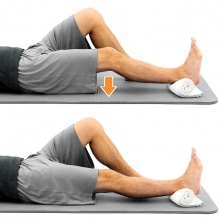
Knee Extension Stretch on Coffee Table
This exercise is an excellent way to get knee extension in the early stages after surgery. Plus, it’s easy to do while you’re watching TV.
Find a comfortable position to sit on the couch or in a chair with a coffee table or another chair in front of you. Lift your surgical leg onto the chair or coffee table and let your leg relax. Allow for gravity to straighten out your knee.
You’ll feel a good stretch behind the knee. Moderate discomfort is normal for this exercise. See if you can hold your knee straight for 30 seconds up to 2 minutes at a time. To help your knee get straighter, you can use your hands to push it straighter.
Video Link: https://www.youtube.com/watch?v=vhEaOeDotqE
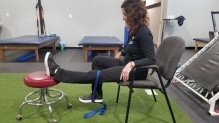
Knee Flexion Heel Slides with Strap
Start by lying down on your back or sitting up against a wall with a stretching strap wrapped around your foot. You can also use a dog leash wrapped around your foot.
If you don’t have a stretching strap (link) you can find an inexpensive one from our recent review. Bend your knee by sliding your foot towards you using your muscles as far as you can. When you’ve gotten as far as you can, use the strap to pull it a little further to get more of a stretch.
Discomfort is normal during this exercise. Hold for 10-15 seconds and then straighten the knee back out. Try to perform 10-20x each session. The goal of this exercise is to improve knee flexion range of motion.
Video Link: https://www.youtube.com/watch?v=A7fcobCVppc

Assisted Range of Motion in Sitting
An easy exercise to do sitting on the couch, at the dinner table, or at the edge of the bed.
Start by sitting with your legs hanging off the side of the chair. Try and straighten your surgical leg as far as you can. Some discomfort is expected. Then using your other leg, help the surgical leg straighten all the way. Hold this position for 3-5 seconds and then bend the knee back underneath you as far as you can.
At this position, place the other leg on top of the surgical leg and help it bend further underneath you. Hold this position for 3-5 seconds. Repeat at least 15-20 times.
Video Link: https://www.youtube.com/watch?v=Ci_iEOLTLzI
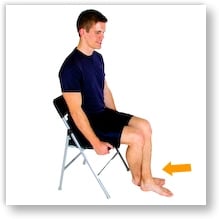
SAQ (Short Arc Quad)
Start by lying down or sitting up with your legs straight in front of you. Place a foam roller or a bolster underneath the surgical leg so that it is bent.
While focusing on how much you can tighten your quad muscle, try and straighten your knee without lifting it off of the bolster. The goal is to get the leg completely straight.
Focus first on getting the knee fully straight and then push to doing 3 sets of 10 reps.
Video Link: https://www.youtube.com/watch?v=00ujVyHyt0g
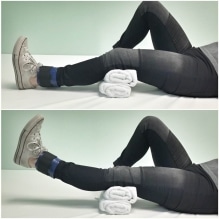
Standing Weight Shifts with a Walker
You can start this exercise on day one after surgery. Start by standing in your walker as tall as you can with normal upright posture. While gently resting your hands on the walker shift your weight as far as you can onto your surgical leg. Hold this position for a few seconds and then shift back towards the non-surgical leg.
The goal of this exercise to get the new knee to be able used to normal weight-bearing. This will help speed up walking and being able to go up stairs. Be sure to tighten your core and the quad muscle as best you can for support.
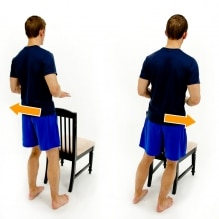
Walking - Forward and Backward
The simplest sounding exercise is the hardest this week. Even though you just had knee surgery it’s important to do as much walking as you can to get back to normal walking mechanics. The sooner you can return to normal walking the happier your knee, back, and hip will be.
First, get up and walk every 30-45 minutes to help keep the knee loose and prevent it from stiffening up. Second, try walking backward for short bouts to retrain your knee and your body on how to walk normally.
We recommend doing this in the kitchen next to the counter or anywhere that you can grab on to something for balance support. Walking backwards is important to train knee flexion back into a normal gait pattern.
Video Link: https://www.youtube.com/watch?v=v0ox_3qAvU8
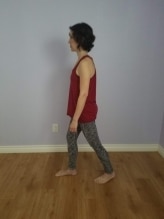
Tips for a Successful First Week After Knee Replacement Surgery
Do Your Exercises Multiple Times a Day
The patients that do the best after a knee replacement are the ones that do their exercises multiple times a day. Sometimes as much as 5-6x a day in the first week isn’t unreasonable.
The exercises are a great way to help with pain, improve strength, and decrease knee stiffness.
Get a Good Nights Sleep
Sleeping is one of the most important times to heal. Yet, after a knee replacement the pain can be so unrelenting that it can be difficult to fall or stay asleep.
There are many different things to try including sleeping in a recliner, using knee extension pillows, and ice packs to help dial down the pain.
Stay Active
The most active you are the less the knee will hurt.
“Motion is Lotion” is the saying in therapy. The more that you bend, straighten and walk on the knee the better that the knee will feel.
Focus on Pain Control
Pain control can come in many different forms and not just by pain medication.
Ice, heat, stretching, elevation, and compression are all ways to help with pain control after a knee replacement.
You Can Start to Use a Light Massager or Massage Gun
Massage is a great way to help with pain and swelling after surgery. Depending on your home situation you might live alone or think there is no chance that your spouse will massage your leg. You can also use a personal hand held massage like the Renpho massager or you can also use a massage gun. Massage guns have become extremely popular in recent years and for good reason, they feel good!
In Review
The right exercises after a knee replacement can make a huge difference. Doing your exercises and staying active can set you up for a speedy recovery after surgery. The more you do your exercises the better you will feel and the sooner you will get back to normal.
Other Great Rehab Related Articles
How to Stay Active After Cervical Fractures: Expert Tips and Advice
Dealing with Painful Stairs After Ankle Replacement Surgery
Walking After a Total Ankle Replacement: Tips for a Successful Recovery
Exercises While Non-Weight Bearing After Ankle Replacement: Elevation, AROM, Leg Raises, and More
Ankle Pain with Stairs: Causes and Home Treatment Options
5 Common Mistakes You’re Making After an Ankle Sprain
Disclaimer: The information provided in this post is for educational purposes only. This is not a substitute for a medical appointment. Please refer to your physician before starting any exercise program.
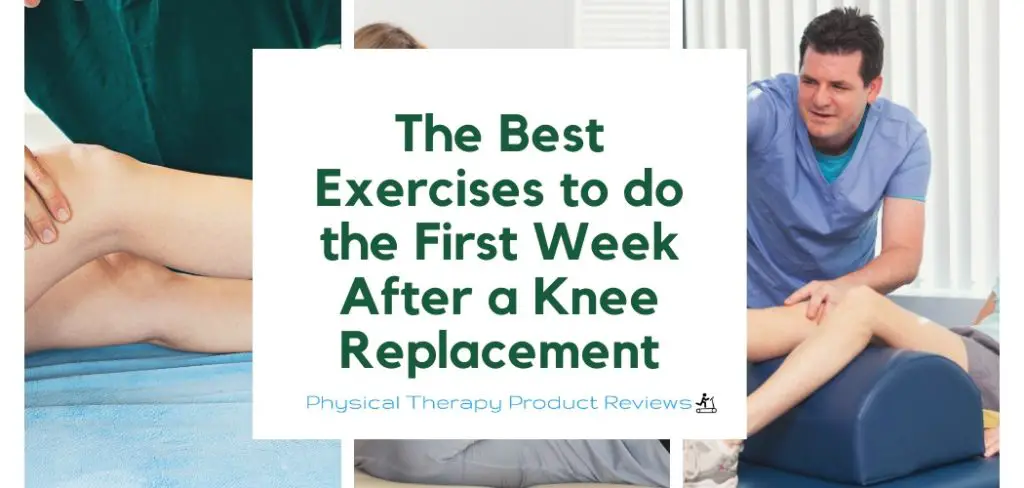







Comments are closed.